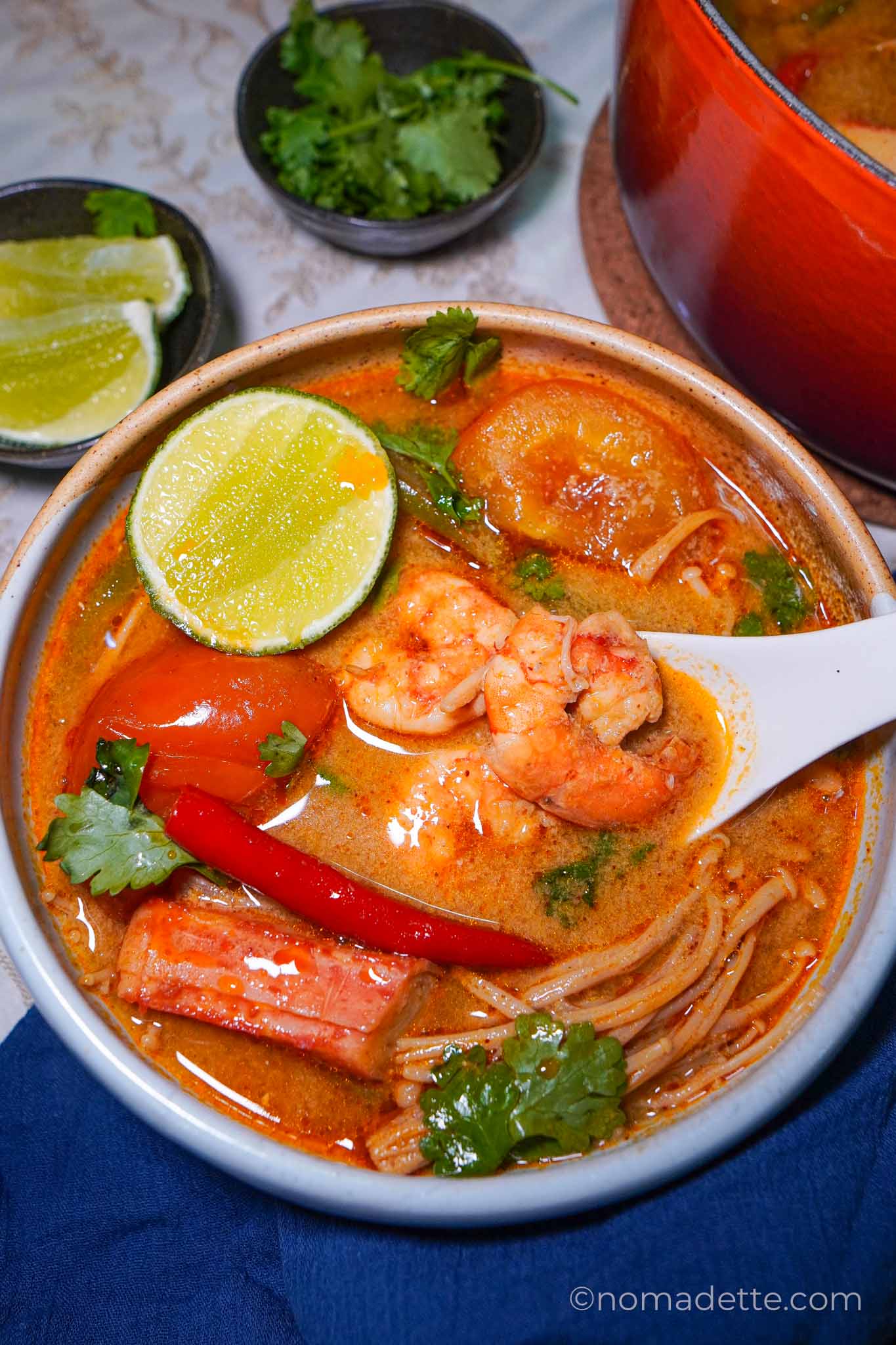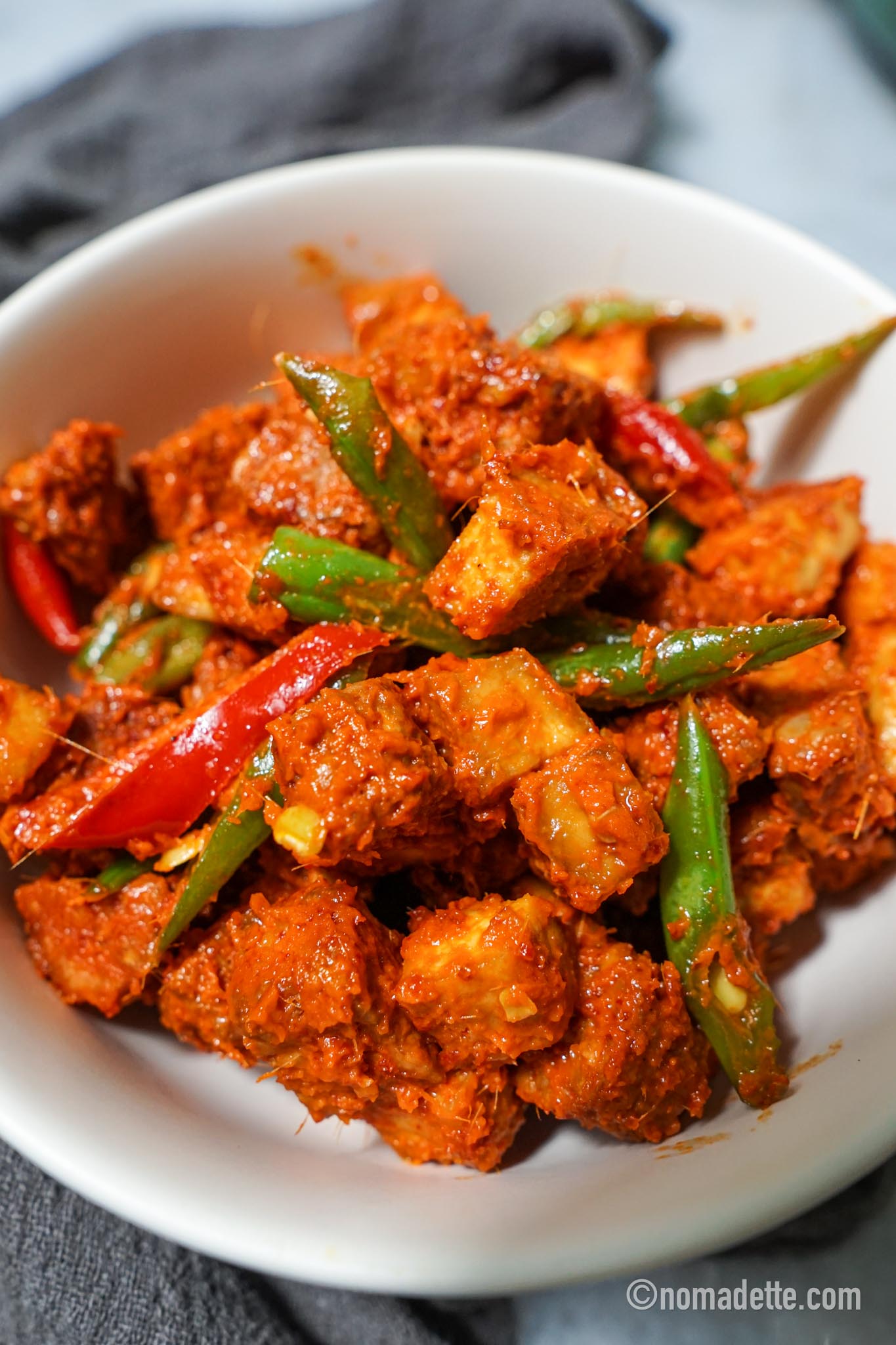How to make Singapore Hokkien Mee, a deliciously flavourful plate of noodles stir fried in the most aromatic seafood broth.

Today we’re making Hokkien Mee, a Singapore seafood noodle dish braised in a gorgeous broth. This is a very unique fried noodle dish – Think of it as seafood risotto but with noodles. I have to have hokkien mee with a spicy sambal sauce so I’ll show you the recipe here too.
Seafood/Prawn Broth
The broth is the single most important ingredient in good Hokkien Mee. For my broth I used about 400g prawn heads, or about heads from 40 prawns. You can use the prawn shells as well, just that I’ve amassed so much prawn heads that I didn’t have to include the shells. This yields good broth for 2 litres of water, but don’t feel like you need this much. 2-300g will also be able to yield good prawn broth.
Thoroughly Frying the Prawn Heads
It’s important to thoroughly stir fry the prawn heads and shells in oil first before adding water. This is to ensure your broth is not fishy. Saute the prawn heads until it turns orange, all liquid would also have been drawn out and evaporated, so that you have dry, almost crispy prawn heads.
Chicken Feet/Spare Parts
The original hawker recipe uses pork and pork lard to give Hokkien Mee that greasiness and extra layer of meaty flavour. Since we don’t use pork, I used chicken spare parts in mine. Chicken feet has more collagen-y fat, to help replicate that fattiness. The chicken spare parts also has fat and flavour. If you’re willing, you can use more chicken parts with skin for the extra fattiness. I rather use those chicken parts for other recipes. You can peel the meat off the chicken after, and add to your Hokkien Mee. Do not add too much chicken though – we want the broth to have a more briny, prawn flavour than chicken.
Ikan Bilis/Dried Anchovies
To further add flavour to the broth, I added ikan bilis or dried anchovies. If you can’t find the small dried anchovies, you can use the bigger dried anchovies that you can easily find at Korean grocers. Other dried seafood can work as well.
I do not season my broth at all. I prefer to add seasoning in the noodle frying process. The broth would also have some taste though. The prawn heads add sweetness, while the the dried anchovies add a hint of salt.
Cheat Instant Broth
No prawn heads or ikan bilis or chicken? Or not enough? Or just plain can’t be bothered? You can cheat with bouillon cubes. Use 2 seafood or ikan bilis bouillon cubes to 2 litres or water, and add half a chicken bouillon cube. I will add that nothing beats the taste of prawn broth though.
Cooking the Seafood
Once the broth is done, boil the seafood in the boiling broth. The seafood used is squid and prawns, of course.
For the squid, I simply removed the head, and the bone within, gave it a good rinse in and out, and simply drop it whole in the broth. Take it out once done, and slice the squid into rings.
I used quite large prawns, I think these are the best and most satisfying for Hokkien Mee. Peel the prawns (add the heads and shells to your broth), and dunk it into your broth. Use a slotted spoon so you don’t lose the prawns.
I also added fish cakes, these are usually pre-cooked, so they just need a few tosses in the wok. You can use fishballs, just slice them up for more bite-able pieces. If your fishballs are not pre-cooked, then boil them in the broth too. Can you use actual fish meat? You can, but it will disintegrate when you’re stir frying it with the noodles.
The seafood cooks quickly – do not overcook, just 2-3 minutes is enough. Cook it for too long and you’ll end up with rubbery squid and mushy prawns.
Frying Hokkien Noodles
The noodle frying process involves braising the noodles with a bit of the seafood broth each time you add an ingredient in. It does not really matter when exactly you add the broth; after or before each ingredient step is good. The broth is ladled in little by little. What this does is that it allows the noodles to absorb the broth without getting soggy, which is why we don’t add the broth all at one go. Frying step by step will allow the noodles to absorb just enough broth, and the heat from the wok/pan, will dry out any excess and char the noodles.
The eggs are scrambled in first – unusual for fried noodles in which eggs are added after the noodles. Letting the eggs cook first again helps to prevent sogginess.
The noodles will eventually become saucy and creamy. For the final ladles of broth, add as much broth as you want sauce. I like noodles rather moist, so I always add an extra ladle in.

Hokkien Mee Sambal Chilli
I cannot have my Hokkien Mee without a dollop of sambal on the side. This is my perfect recipe for the best sambal to go with the Hokkien Mee.









The sambal chili recipe is just what I’ve been looking for! Many thanks for posting it. I had been visiting Singapore since early 2000s every year for two weeks – just to eat hawker food!! Coronavirus has put a stop to that and I haven’t visited SG since 2019, so am currently in the throes of Hawker Food Deprivation Syndrome (HFDS – it is a thing, I’ve just discovered. Well, actually, just invented.) We are adequately supplied with Asian grocery stores here in NZ but it’s sometimes hard to track down individual ingredients that I need to replicate hawker food at home. One of the dishes I really pine for is chwee kueh with a bit of sambal chili on the side, but I’ve never found a recipe on the internet that actually tastes like it was made by someone who knows how Singapore sambal chili should actually taste. Your recipe seems to contain all the elements I would want to experience in sambal chili, so I will be giving it a go in anticipation of my next attempt at chwee kueh.
Hi Terry, thank you for your lovely comment! I also have a serious case of HFDS… and I’m in hawker city! And yes, this sambal chilli recipe goes great with chwee kueh too (I personally vouch). Let me know if you need more help! I have a dedicated post for the sambal in case you need more info: https://nomadette.com/singapore-hawker-style-sambal-chilli-recipe/